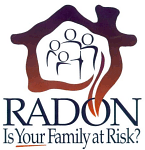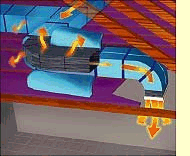Protecting Your Family's Health
Protecting Yourself and Your Family From Radon in the Winter
Winter Heating Safety Resources
Ten Tips to Protect Children from Pesticides and Lead Poisoning around the Home
Energy Efficiency and Resources
Tips to Stay Warm, Lower Your Bills and Help the Environment
Energy Saving for Your Business
Deicing
Products for Your Home ![]()
More Tips for Weathering the Winter ![]()
E-cycling Electronic Gear You No Longer Use
Tips for February Fun Without Waste
Protecting Yourself and Your Family From Radon
 Radon
levels can soar during the colder months when residents keep windows closed
and spend more time indoors. As many as 22,000 people die from lung cancer
each year in the United States from exposure to indoor radon.
Radon
levels can soar during the colder months when residents keep windows closed
and spend more time indoors. As many as 22,000 people die from lung cancer
each year in the United States from exposure to indoor radon.
EPA Administrator Steve Johnson urges Americans to heed January as National Radon Action Month by testing their homes for one of the leading causes of lung cancer in the country, indoor radon gas. Approximately one home in 15 across the nation has unacceptably high radon levels; in some areas of the country, as many as one out of two homes has high levels
EPA Recommends:
- Test your home for radon -- it's easy and inexpensive.
- Fix your home if your radon level is 4 picoCuries per liter (pCi/L) or higher.
- Radon levels less than 4 pCi/L still pose a risk, and in many cases may be reduced.
- Read EPA's "Citizen's Guide to Radon: The Guide to Protecting Yourself and Your Family From Radon."
For more information about radon testing, call EPA's hotline at 800-SOS-RADON or visit EPA's radon web site.
Winter Heating Safety Resources
Hazards may be associated with almost all types of appliances. The purpose of this booklet is to answer some common questions you may have about the potential for one specific type of hazard - indoor air pollution - associated with one class of appliances - combustion appliances.
 Combustion
appliances are those which burn fuels for warmth, cooking, or decorative
purposes. Typical fuels are gas, both natural and liquefied petroleum;
kerosene; oil; coal; and wood. Examples of the appliances are space heaters,
ranges, ovens, furnaces, woodburning stoves, fireplaces, water heaters,
and clothes dryers. These appliances are usually safe. However, under
certain conditions, these appliances can produce combustion pollutants
that can damage your health, or even kill you.
Combustion
appliances are those which burn fuels for warmth, cooking, or decorative
purposes. Typical fuels are gas, both natural and liquefied petroleum;
kerosene; oil; coal; and wood. Examples of the appliances are space heaters,
ranges, ovens, furnaces, woodburning stoves, fireplaces, water heaters,
and clothes dryers. These appliances are usually safe. However, under
certain conditions, these appliances can produce combustion pollutants
that can damage your health, or even kill you.
Possible health effects range from headaches, dizziness, sleepiness, and watery eyes to breathing difficulties or even death. Similar effects may also occur because of common medical problems or other indoor air pollutants. ...more
A Tip about Child Safety
 EPA
has ten good ideas
for protecting your children from pesticides and lead poisoning in your
home.
EPA
has ten good ideas
for protecting your children from pesticides and lead poisoning in your
home.
Winter Air Quality
 EPA
, together with state and local governments, has expanded air quality
forecasting to include year-round, daily information on particle pollution.
"Particle pollution" consists of microscopic particles in the
air that can get deep into the lungs, potentially causing serious health
problems. Unlike summertime ozone, particle pollution can occur throughout
the year. Although particle levels aren't high every day, you should check
your Air Quality Index (AQI) forecasts to determine whether you need to
take action to reduce your exposure. Forecasts, health information, and
maps showing real-time particle levels are available on EPA's AIRNow web
site at: www.epa.gov/airnow.
EPA
, together with state and local governments, has expanded air quality
forecasting to include year-round, daily information on particle pollution.
"Particle pollution" consists of microscopic particles in the
air that can get deep into the lungs, potentially causing serious health
problems. Unlike summertime ozone, particle pollution can occur throughout
the year. Although particle levels aren't high every day, you should check
your Air Quality Index (AQI) forecasts to determine whether you need to
take action to reduce your exposure. Forecasts, health information, and
maps showing real-time particle levels are available on EPA's AIRNow web
site at: www.epa.gov/airnow.
Tips to Stay Warm, Lower Your Bills and Help the
Environment
Improve your home's comfort and save energy and money while doing the right thing for the environment. By using energy efficiently in your home, you can make a difference by preventing air pollution from power plants. Follow EPA's simple recommendations.
Energy Saving for Your Business
Find financial resources, find ENERGY
STAR products and services, calculate your savings, receive free technical
help, get a no-cost upgrade manual, and get recognition for your efforts.
More
Ducts
It's the time of year when homes have their highest energy demand of the year. Heating accounts for 34% of all annual utility usage and is part of what makes an average home twice the emitter of carbon dioxide emissions as a vehicle. Here is a way to reduce the demand for expensive space heating.
 Check
the ducts. To ensure that as much warm air as possible is delivered
through your central system, check the ductwork and wrap any leaks with
duct mastic. Distribution losses (what's lost while air is transported
from your furnace through ductwork to the vents) often amounts to 30%.
So, sealing ductwork could increase efficiency and the warm air you receive
considerably ... keeping you warmer and making your furnace work less.
Check
the ducts. To ensure that as much warm air as possible is delivered
through your central system, check the ductwork and wrap any leaks with
duct mastic. Distribution losses (what's lost while air is transported
from your furnace through ductwork to the vents) often amounts to 30%.
So, sealing ductwork could increase efficiency and the warm air you receive
considerably ... keeping you warmer and making your furnace work less.
Residential Energy Efficiency
 This
software program shows effective
ways to reduce home energy consumption. Topics include insulation,
windows, doors, weather-stripping, and caulking. The expert system feature
allows users to calculate how much they will save by making their homes
more energy efficient. After you enter information about your home and
the energy-saving changes you intend to make, the program uses local utility
and climate data to calculate your savings in money, energy, and reduction
of pollutants. More
This
software program shows effective
ways to reduce home energy consumption. Topics include insulation,
windows, doors, weather-stripping, and caulking. The expert system feature
allows users to calculate how much they will save by making their homes
more energy efficient. After you enter information about your home and
the energy-saving changes you intend to make, the program uses local utility
and climate data to calculate your savings in money, energy, and reduction
of pollutants. More
More Tips for Weathering the Winter 
- Consider using non-toxic de-icing substances such as clean
clay cat litter, sand, or fireplace/stove ash to prevent hazardous waste
from chemicals. Chemical de-icers can be hazardous to your pets, your
trees and shrubs, and the environment. Antifreeze that leak from car
engines and chemical snow melters on driveways, roads, and runways can
pollute surface waters and groundwater through the soil.
- Winterize your vehicle by checking your air filter and fluid levels, checking tires for tread wear and proper inflation, and checking the condition of your windshield wipers. Ensuring your vehicle is ready for weather changes will reduce damage, which prevents waste from broken parts, and will keep you safe on the road.
- If you have a wood-burning fireplace, save your ashes in a tin instead of throwing them away. Cold wood ashes can be mixed in your compost heap to create a valuable soil amendment that provides nutrients to your garden.
- Use electric snow removal products rather than gasoline-powered ones. While electric products consume energy, they do not emit greenhouse gases. As alternatives, use snow shovels, ice crackers, and brooms to clear snow from your sidewalk, porch, or driveway.
- If you have a manual thermostat or no thermostat at all, one way to save energy and money this winter is to install an ENERGY STAR qualified programmable thermostat. When installed and used with the four pre-programmed temperature settings for weekend and weekdays, you can save about $100 each year while staying comfortable. Before leaving for vacation, turn down your thermostat (or use a programmable one) so that you don't waste natural resources by generating unneeded heat. You can also buy outdoor and indoor lights with timers so that lights don't stay on all night.
- Close the recycling loop. Many articles of clothing, such as jackets, scarves, gloves, and boots, are now made from recycled materials. Most fleece products are made from recycled plastic soda bottles, and certain clothing and shoe manufacturers use recycled cotton scraps and rubber tires to make their products.
- Winter storms often cause power outages. Prevent waste by keeping rechargeable batteries rather than disposable ones stored throughout your house with your flashlights. If you do use disposable batteries, prevent hazardous waste by buying batteries with low mercury content.
- Recycle old newspapers by making rolled paper logs for your fireplace. Roll newspaper sheets around a broom stick until your log is the desired size, then soak your log thoroughly in water. Dry the log overnight and use like ordinary wood. Always follow proper safety precautions when burning anything around your home.
- To make sure your heating system (boiler, furnace or heat pump) is operating at its most efficient, it is a good idea to have a contractor perform a routine check-up and any necessary maintenance on the equipment before freezing weather drives up your energy bill.
- If your heating equipment more than ten years old, it may be time for a replacement to a more energy-efficient unit. While initially an expensive investment, replacing old equipment with ENERGY STAR qualified equipment saves more energy and money in the long run.
E-cycling Electronic Gear You No Longer Use
 Is
your old TV serving as a coffee table while your retired computer is doubling
as a plant stand? And with new technology introduced every day-more powerful
computers, HDTVs, and combination wireless phone and internet, do you wonder
just how many plant stands and coffee tables you have room for?
Is
your old TV serving as a coffee table while your retired computer is doubling
as a plant stand? And with new technology introduced every day-more powerful
computers, HDTVs, and combination wireless phone and internet, do you wonder
just how many plant stands and coffee tables you have room for?
You are not alone-that's why EPA launched a campaign to get the word out about opportunities to reuse and recycle your old computers, TVs, and cell phones.
Motivate yourself to start E-cycling by watching a short video.
Tips for February Fun Without Waste
This Valentine's Day, show your love for the earth by sending recycled-content greeting cards. Consider making new cards from scrap paper or by attaching new backs to the fronts of old cards—this can be a craft project for family and friends that helps everyone reduce paper waste while saving money! Also consider sending electronic valentines. More En Español
![[logo] US EPA](https://webarchive.library.unt.edu/eot2008/20081108013139im_/http://www.epa.gov/epafiles/images/logo_epaseal.gif)
